us toll free: 1-800-948-5563 international: +1 (843) 849-0283 UK: +44 (0) 1334 260018
"Good as it is to inherit a library, it is better to collect one." ~Augustine Birrell
http://www.dictionary.com/browse/rare-book
Allow us to be a resource for you as you work to build your collection. Whether you’re motivated to amass a library of your own for financial reasons, for the personal satisfaction and enjoyment you get from this ‘hobby’, or for posterity’s sake, we have the tools to assist you.
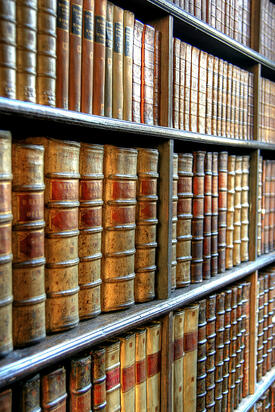
We've put together a running Glossary of Rare Book Terms, and you can find it here. Collectors know firsthand how important it is to recognize the terminology used in descriptions of books for sale. After all, no one wants to be bamboozled because they failed to understand just what they were buying.
Of course, printing and publishing a book has many steps, and when it comes to collecting rare books, the pre-publication material can be as valuable (if not more so) than the actual book. For example, what do you know about Advanced Reading Copies? What are the terms to distinguish these unique collectible items? Read More >>
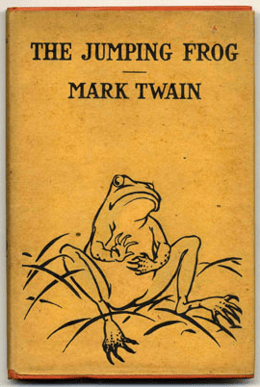 Boards – The stiff material commonly referred to as the covers. Boards were historically made of wood, but most modern binders use cardboard.
Boards – The stiff material commonly referred to as the covers. Boards were historically made of wood, but most modern binders use cardboard.
Bowed – A condition where the boards of a hardcover book have turned either inwards or outwards in relation to the leaves. This often occurs because of a rapid change in moisture.
Cocked – Spine cocked refers to book that is twisted in a way that the front and back boards don't line up when the book is laying flat. Shelf cocked refers to a book that cannot stand perpendicular to the shelf (also called a spine lean).
Dos-à-dos – In dos-à-dos binding (from the French for "back-to-back"), two books are bound back-to-back so that they share one lower board as back cover and open in opposite directions. This binding form was popular from the 17th century onward. The proper terminology for this type of binding is tête-bêche (from the French for head-to-toe), but dos-à-dos binding is used more loosely as an over-arching term for this type of binding.
Dust Jacket - The (mostly) paper jacket which is wrapped around most modern books to protect the cloth covers. Sometimes (often in the United Kingdom) called a dust wrapper, it often includes information about the book and author. The earliest recorded dust jackets date from the early nineteenth century. (The dust jacket pictured above from Mark Twain's The Jumping Frog is from 1903.)
End Papers – Double leaves bound in at the front and rear of a book after printing. One leaf is pasted to the board, with the other remaining free. Usually, the end papers are blank, and thus they make an ideal location for an author's signature.
Flyleaf – The extra blank page (leaf) after the end papers.
Folio – Multiple pages of text (two to a side, four total) printed on a full sheet of paper that is then folded only once to produce two leaves, or four pages. May also be abbreviated with: fo or 2°. Folio is also used to describe the general size of a book if it’s about 15 inches.
Full Bound – a binding style in which the book is bound in one material (leather, cloth, etc.).
Joint and Hinge – The joint is the exterior element where a board joins the spine and bends when opened. The interior side is the hinge, which can be covered in endpapers.
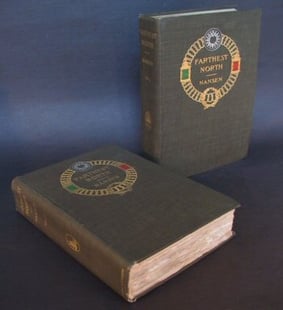 Half bound – a binding style in which the spine and a small portion of the sides or the corners of a book are bound in one material and the sides are covered in a different material.
Half bound – a binding style in which the spine and a small portion of the sides or the corners of a book are bound in one material and the sides are covered in a different material.
Head – The aptly named top edge of the book.
Headband – A decorative band, usually colored, which originally protected the top and bottom edges of the spine but in modern books is strictly decorative. The band can be plain or colored, and was originally worked over leather, cord, or rolled paper.
Leaf – A single sheet of paper or parchment that comprises one page on the front side (recto) and another on the back (verso).
Octavo - Multiple pages of text (eight to a side, sixteen total) printed on a full sheet of paper that is then folded three times to produce eight leaves, or sixteen pages, after cutting the seams. May also be abbreviated with: 8vo, 8°, or In-8. The name octavo comes from the fact that each leaf is about 1/8 the size of the original full sheet.
Paste-Down – Part of the end papers that are glued to the inner boards of a hardback book and extend to coat the inside edge of the books binding. The paste-down is crucial to maintaining the structure of the book, as it forms part of the hinge.
Quarter bound – a binding style in which the spine and a small portion of the sides of a book are bound in one material and the sides are covered in a different material. Note: the corners of a book are not bound in the same material as the spine, thus differentiating quarter binding from half binding.
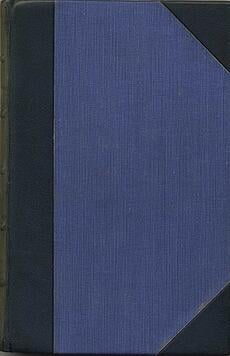 Quarto – Multiple pages of text (four to a side, eight total) printed on a full sheet of paper that is then folded twice to produce four leaves, or eight pages, after cutting the seams. May also be abbreviated with: Qto, 4to or 4°. The name quartocomes from the fact that each leaf is about 1/4 the size of the original full sheet.
Quarto – Multiple pages of text (four to a side, eight total) printed on a full sheet of paper that is then folded twice to produce four leaves, or eight pages, after cutting the seams. May also be abbreviated with: Qto, 4to or 4°. The name quartocomes from the fact that each leaf is about 1/4 the size of the original full sheet.
Shaken – Used to describe a book whose pages have become loose in their binding; no longer tight, but not detached.
Starting Hinge – Sometimes referred to as a "cracked hinge", a starting hinge refers to an instance where the cover still attached at the hinge, but the endpaper is beginning to split.
Tail/Foot – The aptly named bottom edge of the book.
Three-Quarter Bound – a binding style in which the spine and the majority of the sides of a book are bound in one material and a second material covers the remaining sides; also used when the spine and a large portion of the corners are bound in the same material.
Tipped-In – A technique where pages, plates, or signatures are glued into the book post binding of the book.
Warped – Term used to describe a book or dust jacket that has become distorted or bent out of shape, often due to moisture, dryness, or improper care.

Age or scarcity alone are hardly sufficient to make a rare book also valuable. Books are valued for the significance of their contents, their scarcity, their imprint or date of publication, their physical characteristics or condition, or their associations (signed or annotated by a famous author, for instance). The importance of the text and its sources, the condition of the book, and demand for it will determine the financial valuation of an old book. Learn more about the following factors in gauging a book's value by clicking on the links below.
As most collectors are aware, a dust jacket in fine condition can greatly enhance the value of a book. Indeed, for modern first editions, a book without the dust jacket will sell for only a fraction of the price. Once intended to be temporary and disposable protection for beautifully bound books, dust jackets have become--in some ways--more valuable than the books they protect. Read More >>
Throughout the nineteenth century--and even beyond--dust jackets were intended to be disposable. As such, they were often discarded after purchase. Given their frail construction and the likelihood of them being thrown away, it can be quite rare to find
There is never a wrong time to think about how best to care for your rare books. Factors such as moisture and humidity and the storage of your collection can have a significant impact on how well your books retain their value.
So you’re a book collector. Perhaps you’re just starting out, or maybe you’ve amassed a sizable collection. You have researched the proper methods to protect your books from the elements—things like proper humidity control and winning the battle against bookworms. Your book collection is your pride and joy, and you’re looking forward to passing it down to your kids and grand-kids someday, or donating it to a favorite museum or institute. Excellent. Now, have you considered how you should insure your book collection? If not, you should. We've been asked recently about how to insure book collections. Here are several things to think about when it comes to protecting your investment.
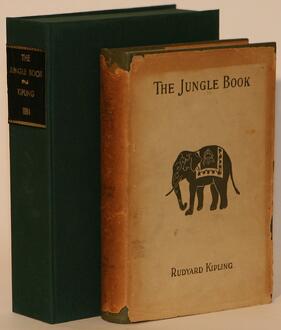 Often, collectors make the mistake of assuming that if they have a homeowner’s insurance policy, their book collection will be covered. Unfortunately, this is often not the case. A homeowner’s insurance policy will not cover your collection in the event of a fire, flooding, earthquake, or other natural disaster. Homeowner’s insurance policies cover costs more generally, but will not give you the replacement value of your rare or valuable books in the event of a loss.
Often, collectors make the mistake of assuming that if they have a homeowner’s insurance policy, their book collection will be covered. Unfortunately, this is often not the case. A homeowner’s insurance policy will not cover your collection in the event of a fire, flooding, earthquake, or other natural disaster. Homeowner’s insurance policies cover costs more generally, but will not give you the replacement value of your rare or valuable books in the event of a loss.
Every insurance company is going to have different verbiage or titles on insurance policies as they relate to rare book collections. Be sure to talk to your insurance agent to determine what is the best option for you. Look into a rider on your existing policy that specifically covers collectibles like rare books.
We recommend researching specialty insurance companies whose sole focus is on these more nuanced policies, something like collector’s insurance or fine-arts policies, for example. The way it was described to us: a book collection is a specific entity like fine jewelry or a classic car, and as such, it’s helpful to go with a specialty carrier for your insurance needs. In fact, several general insurance agencies will actually defer to or even go so far as to refer you to a specialist to ensure your book collection is protected properly.
Across the board, the insurance industry experts we talked with stressed the importance of accurately documenting your inventory. Make sure you have a written list of the books in your collection: title, author, edition, publication date, condition, etc. Save your receipts if you can. You can’t be too thorough. Be sure to continually monitor the worth of your collection so you can account for increases in value.
In the same vein, document your collection with photos. Often, for convenience, insurance companies offer the capability to take and store photos right within their particular mobile app. However you do it, be sure you have photos of your collection.
In the event of a loss, the claims adjuster will use your documentation to assess and offer payment to replace your collection.
It’s widely understood that no one cares much about insurance until they need it, at which point, it’s often too late. Be proactive, and don’t leave your valuable book collection unprotected. Look into appropriate insurance today to save yourself some serious grief tomorrow.
We receive many emails from book collectors and individuals who have purchased books from our inventory. We’re asked a lot of questions about book collecting, the history of a certain collectible or title, etc. We love hearing from you, and we try our best to answer your inquiries. Recently, many of you seem to be wondering about book care, particularly book storage, and how to store your books in a way that ensures the preservation of your collection. We thought we’d share some answers and some of our favorite resources.
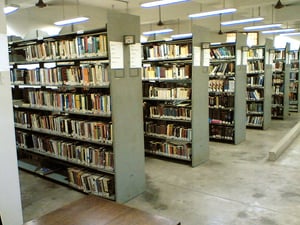 Often when picturing book collections, in our mind’s eye we envision floor to ceiling wooden bookcases. There’s just something about wood, isn’t there? Warm, charming, and actually quite troublesome for books.
Often when picturing book collections, in our mind’s eye we envision floor to ceiling wooden bookcases. There’s just something about wood, isn’t there? Warm, charming, and actually quite troublesome for books.
Indeed, wood shelves and book cases are not recommended for storing a book collection due to the acid present in wood that can be transferred to the books, causing deterioration. As the Northeast Document Conservation Center (NDCC) states, “[t]o avoid potential damage to collections, storage furniture made of wood or wood products should be avoided. If this is not possible and wood must be used, precautions are necessary.”
What are these precautions? First, if using wood is necessary, you can select a type of wood that has the lowest incidence of emission. The NDCC notes that Oak is particularly egregious in terms of its acidity, and as such, it should be avoided. Woods can be tested to determine their usability and what risk they pose to your collection.
All wood furniture used for book storage should be sealed. Research is necessary to determine the best sealant options. Sealants themselves can emit harmful substances for books, and some serve as better barriers than others. The NDCC provides a good breakdown of current best-practices here. You’ll also find its recommendation for the best non-damaging furniture for book storage through the same link.
We’ve written before about the necessity of a proper storage environment for your book collection. Keep the relative humidity in the room where you house your collection between 35-50%. Excess humidity can cause foxing. If you live in a humid area, you can employ a dehumidifier to help you maintain a moderate storage environment. We always recommend keeping an eye on the environment where you store your collection. Several of our best storage environment ideas can be found in this post. We highly encourage book collectors to remove books from direct sunlight. While short-term exposure isn't the end of the world, long-term UV exposure will fade the dust jackets and covers of rare books and accelerate decomposition. Likewise, it is important to know your materials, as different materials require different environmental conditions.
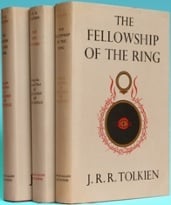 A couple other book care tips that often come up involve how best to organize your books. We always recommend storing books of similar size together. That way, you ensure that each book is maximally supported by its neighboring books. In the same way, when you store your books, be sure they are straight and not leaning. This will help preserve the binding and covers. Be sure that books are properly supported using appropriate bookends when necessary. Lying books flat is another smart option, especially when dealing with particularly heavy books.
A couple other book care tips that often come up involve how best to organize your books. We always recommend storing books of similar size together. That way, you ensure that each book is maximally supported by its neighboring books. In the same way, when you store your books, be sure they are straight and not leaning. This will help preserve the binding and covers. Be sure that books are properly supported using appropriate bookends when necessary. Lying books flat is another smart option, especially when dealing with particularly heavy books.
How to best store paper items (ephemera, unbound essays, speeches, pamphlets, etc.) is another frequently asked question. We like to point collectors to the Gaylord Archival website as a resource in this case. There are several case studies listed which detail best practices for storing a number of paper collectibles. You can read more here.
As far as cleaning your book collection, to rid books of dust, it’s best to use a magnetic dust cloth or a magnetic wiping cloth. Of course, there are exceptions to this rule, particularly if any of your books have untrimmed edges. Likewise, use caution when cleaning any books with chipped or flaking dust jackets or covers. The NDCC has a thorough article on book cleaning tips here.
If you’re a novice collector and looking for a place to start your book collection, what should you consider? The process is filled with nuances, and there are perhaps as many ways to go about forming a collection as there are collectors. However, some universal truths are present in the book collecting world. Here, we’ve compiled a brief guide to help you along your collecting ways. Read More >>
Want even more information? Click the links below.
With so much book shopping and book collecting taking place on the internet these days, it might be difficult to imagine why travel can be an important part of building a rare or antiquarian book collection. We’ve become so reliant upon the internet for almost everything these days, and book buying is one of them. However, let us emphasize just how valuable it can be to travel to different parts of the United States and, indeed, different regions of the world, as you build your collection. When physical bookstores are available, not only can you engage with the book as a physical object, but you can also discover out-of-print or even self-published titles that you didn’t know existed.
If you want to build a truly unique collection, consider traveling to new places and visiting bookshops that can help you to unearth new and never-before-seen titles to add to your bookshelves. The resources available from the Antiquarian Booksellers’ Association of America(ABAA) and the International League of Antiquarian Booksellers (ILAB) can help you to locate shops, but in addition, there may be hidden treasures just around the corner with no internet presence at all. Let me tell you a bit more about the pleasures of book-buying travel and some tips for the globetrotting book collector.
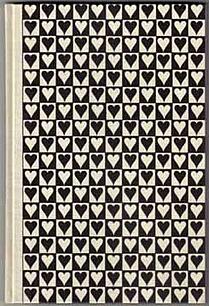
One of the first and most obvious reasons for traveling to buy books is that you highlight the significance of the book as a physical object. With so many bookstores going out of business and readers turning to e-copies, we need more emphasis on the power of the physical book. You can hold the object in your hands, and you can examine its condition. But even more importantly, visiting bookstores allows you to discover items that aren’t catalogued online.
When you travel to different parts of the country or the world to buy books, you never know what you might find. While you may have specific titles or printings in mind that you’re seeking out on your trip, there are always going to be titles, objects, and pieces of ephemera that you simply didn’t expect to find. Some booksellers don’t maintain online catalogues, and some only list parts of their inventories. Without traveling to these bookstores in person, you could be missing out on some incredible out-of-print and self-published titles. Here are just a handful of examples:
In Kraków, Poland, one of our writers visited the rare and antiquarian bookstore Rara Avis. Searching through binders upon binders of ephemera, she discovered a 1955 theater program printed by the Polish avant-garde student political theater group Bim-Bom. The program contained a Polish translation of Pablo Neruda’s “Let the Woodcutter Awaken” on the front page, including a colorful linocut image to accompany the poem. The program was made to be given out during the theater group’s show that year, and as such, relatively few were printed. She would never have known the pamphlet was at this shop—let alone existed—but for a book-buying trip to Kraków.
As another example, upon visiting the enormous rare and antiquarian bookstore Collector’s Treasury in Johannesburg, South Africa, one of our writers found a very exciting Nadine Gordimer item. First, some brief background: Gordimer’s novel Burger’s Daughter (1979) was banned in South Africa at the time of its publication due to its vehement anti-apartheid politics. It was published in the U.K. by Jonathan Cape, and copies found their way back into South Africa. Inside Collector’s Treasury, she found a U.K. first edition of Burger’s Daughter with an original price tag attached—a price in South African Rand. In other words, she happened upon a copy that had been priced (and perhaps sold) “illegally” in South Africa at the time of the book’s banning. What a find!
And for one more Neruda story: in Reykjavik a few years ago, our writer arranged an interview with the owner of the last antiquarian bookstore in Iceland. She told the owner that she collects Neruda’s books in various global translations—as she tells all rare booksellers I meet. The bookstore owner instantly took a liking to her and tried to convince her to have dinner with him. Eventually, she gave into a lunch in hopes of seeing a rare Neruda translation he had in his possession. The bookstore owner brought out a handbound, self-published book of Neruda translations, done by hand, by one of Iceland’s most famous 20th-century poets, Dagur Sigurðarson. The poet, as it turns out, had been close friends with the bookstore owner’s father—also a rare bookdealer—in the ‘60s and ‘70s.
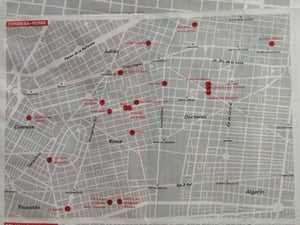
Before you travel, make a list of the bookstores you plan to visit and their locations as best as you can. Remember that many bookstores have listed physical addresses, but some may be tiny shops that have absolutely no internet presence—you could happen upon them walking down the street. This is certainly true of bookstores in Santiago, Chile, Buenos Aires, Argentina, and Mexico City, Mexico. Pinpointing shops on a walking map is one of my favorite ways to ensure that you've visited all of the bookstores on your list, and it’s also a fantastic way to see any city. And as mentioned, you’ll very likely end up walking by shops that you haven’t seen listed anywhere. Pop inside and see what you can find.
Next, talk to booksellers and tell them what you’re seeking out. Once you do, you could be surprised at the world in which you find yourself.
And finally, but not least importantly, if you arrive to a new place and learn that the bookstore offerings aren’t quite what you had hoped, don’t give up. Indeed, book-buying travel doesn’t quite turn out the way you’ve planned. Traveling to Northern India several years ago, we anticipated a number of rare and antiquarian bookshops and only found one in Bombay. That shop ended up having an incredible Rabindranath Tagore catalogue that we excitedly purchased for a collection of postcolonial literature. Similarly, on a recent visit to Nairobi, Kenya, one of our writers had high hopes for the rare and antiquarian book trade in the East African metropolis after reading a number of stories about bookstores in the city. Unfortunately, upon arrival, she learned that all of them have now closed.
No matter where you go, you’re likely to be able to find rare and antiquarian bookstores with incredible works that are waiting to go into your collection. And even when you strike out, the hunt itself is part of the joy of book collecting.
A signed book is a sought-after collectible for a bibliophile, and it can add exponential value to a book collection. Learn the difference between a dedication copy, an association copy, a presentation copy, and an inscribed copy in order to best add to your book collection. You can read more about the types of signatures and inscriptions, as well as good places to find signed copies, through our guide here.
The authenticity of signed books and signatures in particular is the number one element of the trust a reputable seller of autographed books is hoping to establish and maintain with their customer.
We are proud to offer a table of author signatures, obtained in controlled environments, to assist in the authentication process of signed books.
"How many cities have revealed themselves to me in the marches I undertook in the pursuit of books!” ~Walter Benjamin
If you’re traveling, be sure to research accredited book stores in the city you’ll be visiting. The ILAB and AABA provide lists that are helpful. Also, check ahead to ascertain working hours of bookstores you’d like to visit. We’ve traversed the world over in pursuit of collectibles, so we’ve done some of the footwork in the following locations. Click on the links to find personalized book collecting travel guides.